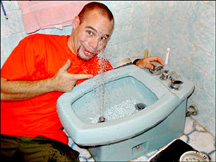Chesapeake Bay's Independent Newspaper ~ Since 1993
1629 Forest Drive, Annapolis, MD 21403 ~ 410-626-9888
Volume xviii, Issue 1 ~ January 7 - January 13, 2010
Home \\ Correspondence \\ from the Editor \\ Submit a Letter \\ Classifieds \\ Contact Us
Dining Guide \\ Home & Garden Guide \\ Archives \\ Distribution Locations \\ Advertising
![]()



From the Editors of |
Got an Environmental Question? Send it to: EARTH TALK, c/o E/The Environmental Magazine, P.O. Box 5098, Westport, CT 06881. Or submit your question at: www.emagazine.com. Or e-mail us at: [email protected]. |
Save a Tree; Use a Bidet
We flush 15 million trees down our toilets each year
Wouldn’t a return to installing bidets in bathrooms at home go a long way
toward cutting disposable tissue use and saving forests?
–Peter K., Albany, GA
Besides being more sanitary than toilet tissue, bidets — those squirty accessories so popular in Europe, Japan and elsewhere that clean your underside using a jet of water — are also much less stressful on the environment than using paper.

![]() Justin Thomas, editor of the website metaefficient.com, considers bidets to be “a key green technology” because they eliminate the use of toilet paper. According to his analysis, Americans use 36.5 billion rolls of toilet paper every year, representing the pulping of some 15 million trees. And that’s not all. “This also involves 473,587,500,000 gallons of water to produce the paper and 253,000 tons of chlorine for bleaching,” says Thomas. Manufacturing requires about 17.3 terawatts of electricity annually, and significant amounts of energy and materials are used in packaging and in transporting toilet paper to retail outlets.
Justin Thomas, editor of the website metaefficient.com, considers bidets to be “a key green technology” because they eliminate the use of toilet paper. According to his analysis, Americans use 36.5 billion rolls of toilet paper every year, representing the pulping of some 15 million trees. And that’s not all. “This also involves 473,587,500,000 gallons of water to produce the paper and 253,000 tons of chlorine for bleaching,” says Thomas. Manufacturing requires about 17.3 terawatts of electricity annually, and significant amounts of energy and materials are used in packaging and in transporting toilet paper to retail outlets.
If you fear bidets waste water, advocates counter that the amount is trivial compared to how much water we use to produce toilet paper in the first place. Biolife Technologies, manufacturer of the high-end line of Coco bidets (biolifetechnologies.com), says the amount of water used by a typical bidet is about 1/8th of a gallon, with the average toilet using about four gallons per flush.
Lloyd Alter of the website treehugger.com reports that making a single roll of toilet paper requires 37 gallons of water, 1.3 kilowatt/hours of electricity and some 1.5 pounds of wood. Toilet paper is also a public nuisance in that it clogs pipes and adds a significant load onto city sewer systems and water treatment plants.
“Basically, the huge industry of producing toilet paper could be eliminated through the use of bidets,” says Thomas, who has been testing different toilet-seat mounted units for the past two years. He would like to someday pair a bidet with a composting sawdust toilet for the ultimate green bathroom experience.
Once reserved for Europeans, bidets are now popular all over the world — except in North America. Thomas reports that 60 percent of Japanese households today have high-tech bidets made by Toto called Washlets (www.totousa.com), while some 90 percent of Venezuelan homes have bidets. Most people use a small amount of paper to dry their posteriors after the bidet has done its job, but more expensive air-drying models dispense with the need for paper altogether.
Bidets provide important health benefits such as increased cleanliness and, Thomas says, “the therapeutic effect of water on damaged skin (think rashes or hemorrhoids).”
On the public health front, bidet maker BioRelief reports that almost 80 percent of all infectious diseases are passed on by human contact and that only about half of us actually wash our hands after using the facilities — making hands-free bidets a safer alternative all around.
“If you don’t have to use your hands at all then there is less chance of passing or coming in contact with a virus,” claims the company. BioRelief’s full featured BidetSpa sells for $549, but Lloyd Alter reports that consumers willing to go without heated water and air-drying mechanisms can get a perfectly adequate one they can install themselves for less than $100, such as the Blue Bidet (www.bluebidet.com), which retails for just $69.
Got an environmental question? Send it to: EarthTalk, c/o E/The Environmental Magazine, P.O. Box 5098, Westport, CT 06881; submit it at www.emagazine.com/earthtalk/thisweek: or e-mail [email protected]. Read past columns at: www.emagazine.com/earthtalk/archives.php
© COPYRIGHT 2010 by New Bay Enterprises, Inc. All rights reserved.